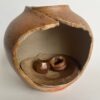ARTIST STATEMENT
I make work about the spaces I inhabit and the passing of time, about the person I was in those spaces. I chose painting as my main medium four years ago because it lets me sit with a moment long enough to really remember it. When I paint, I recall who I was, who I surrounded myself with, what I loved and disliked, the music, the light, the mess, the quiet. Every portrait I make holds a memory, a specific moment I can speak to. I paint so that I can remember. A big part of who I am is shaped by what and who I’ve lost. My mother died when I was 18, my father when I was 24. Their deaths changed the entire course of my life. I often fantasize about who I might be if I hadn’t known that kind of heartbreak. But their loss also made me understand the weight of tangible things left behind: photos, perfume, hair grease, letters. Our remnants matter. They tether us to care and memory. In that way, my work is both an offering and a record. It’s a way to be remembered and to remember myself.
ABOUT THE ARTIST
Ashley Martin is an artist, curator, and arts administrator whose practice is rooted in memory, intimacy, and the emotional residue of place. Her work uses portraiture and domestic space as portals—sites where grief, self-love, and personal history coexist. Through texture and color, Ashley explores care as an ongoing act: of witnessing herself, of tending to loss, of honoring loved ones, and of creating room to return to the body. Alongside her artistic practice, Ashley serves as the Community Engagement Internship Coordinator at The Ohio State University’s Urban Arts Space. There, she designed and leads a program that bridges professional development with social impact—connecting young adults to community-based arts organizations where they gain experience in advocacy, collaboration, and creative leadership. Her work is a testament to the belief that care is not passive; it’s intentional, daily, and deeply relational. Ashley sees painting as a form of remembrance and offering. Whether depicting a loved one or the spaces that have shaped her, her work invites slowness and care. Her practice asks: What does it mean to tend to ourselves and each other? Through this question, she builds a visual language of softness, presence, and survival, one that honors vulnerability as a strength and care as a practice of resistance.
© Ashley Martin



